A sludge dryer takes water out of sludge. This makes the sludge lighter and easier to move. In wastewater treatment, drying sludge can make it smaller and lighter. This helps save money when getting rid of it. For example, getting rid of sludge can be up to 65% of running costs in some places:
Cost Category | Percentage of Total WWTP Operational Costs |
|---|---|
Sludge disposal costs | 58% to 65% (province of Trento, Italy) |
Processing excess sludge | 25% to 65% (general WWTP operational costs) |
Cities and factories use sludge dryers. They make sludge dry and small. This makes it easier to move and take care of.
Основные выводы
A sludge dryer takes water out of sludge. This makes the sludge lighter and smaller. It is easier to move and handle. Drying sludge helps save money. It lowers the cost to move and get rid of sludge. It also helps stop bad smells and germs. There are many kinds of sludge dryers. Each one works best for certain sludge and drying jobs. Dried sludge can be used again. It can be fertilizer, fuel, or help soil. This helps the environment. Picking the right sludge dryer is important. Using new technology can make things work better. It can also help save energy.
What Are the Basics of Sludge Drying Technology?
Sludge drying technology involves removing water from sludge to reduce its volume and weight, thereby making disposal easier and more cost-effective. This process typically includes mechanical dewatering followed by thermal drying.
What Is a Sludge Dryer
A sludge dryer is a machine that takes out extra water from sludge. Sludge comes from wastewater or factories. It often looks like a thick, wet cake. Mechanical dewatering removes some water, but a lot stays. Sometimes, more than 80% of the sludge is still water. A sludge dryer helps by removing even more water. This makes the sludge lighter and easier to move.
Sludge drying happens after mechanical dewatering. It uses heat or special electric methods to get out more water.
The process spreads sludge in the dryer and uses heat or electro-osmosis to dry it.
Drying can use hot air, heated surfaces, or even solar energy.
The dried sludge is safer and easier to store, move, or reuse.
A sludge dryer has a few main parts:
A feed system brings wet sludge into the machine.
The drying chamber is where heat takes out the water.
The heating system uses fuels like natural gas or electricity.
An exhaust system removes water vapor and gases.
A control system checks and manages the whole process.
Sludge dryers help cities and factories by making sludge smaller and lighter. This makes it cheaper to move and get rid of. Dried sludge can also be used as fuel, fertilizer, or soil conditioner.
Tip: Drying sludge saves money and helps the environment. It reduces bad smells and germs.
Types of Sludge Dryers
There are many types of sludge dryers. Each type works best for certain sludge and drying needs. The main types are:
Лопастная сушилка: Uses heated paddles that turn and mix the sludge. This type is good for sticky sludge and can reach high solids content (up to 90%). It does not need extra mixing because the paddles keep the sludge moving.
Belt Dryer: Moves sludge on a belt through hot air. The ленточная сушилка can use waste heat and works for both city and factory sludge. It can dry sludge to a high solids level and uses energy in different ways.
Роторная барабанная сушилка: Turns sludge inside a spinning drum while blowing warm air through it. This type handles large amounts of sludge and works for both city and factory waste. It can dry sludge to a high solids content but may lose more heat and make more odor than other types.
Thin Film Dryer: Spreads sludge in a thin layer on a heated wall. A rotor stirs the sludge, helping it dry fast. This type is good for heat-sensitive sludge and can reach about 65% solids.
Disc Dryer: Uses heated discs and steam to dry sludge. It works well for partial drying and often pairs with other systems for full treatment.
Solar Sludge Dryer: Uses sunlight in a greenhouse with machines that turn the sludge. This method works best in sunny places and can dry sludge to about 65% solids.
Drying Beds: These are simple outdoor beds where sludge dries in the sun. They cost less but take more time and space.
Тип сушилки | Механизм сушки | Drying Completeness | Оперативные заметки |
|---|---|---|---|
Лопастная сушилка | Indirect conduction via heated rotating paddles | High solids content (80-90%) | Good for sticky sludge; no extra mixing needed |
Thin Film Dryer | Indirect conduction on heated wall with rotor | Partial drying (~65% solids) | Good for heat-sensitive sludge |
Роторная барабанная сушилка | Convective drying with warm air in drum | High solids content | Handles large volumes; may lose more heat and odor |
Belt Dryer | Convective drying with hot air on moving belt | High solids content | Flexible energy use; can use waste heat |
Each sludge dryer can dry different amounts of sludge. Some handle small amounts, while others dry a lot every day. The right choice depends on the type of sludge, how much needs drying, and what the plant needs.
Note: Picking the right sludge dryer helps dry more sludge and saves energy.
Why Sludge Drying?
Sludge drying is essential for reducing the volume and weight of sludge, making it easier and more cost-effective to handle, transport, and dispose of. This process also stabilizes the sludge, reducing odor and pathogens, thus minimizing environmental impact.

Volume and Weight Reduction
Sludge drying takes out most of the water from sludge. Wastewater sludge usually has 70–90% water at first. After drying, it has less than 20% water left. This makes the sludge much lighter and smaller. For example, if you dry sludge from 99.5% to 70% moisture, its volume drops by over 98%. Smaller sludge means trucks can carry more at once. This saves money on moving and storing it. The chart below shows how much the volume goes down as the water content drops:
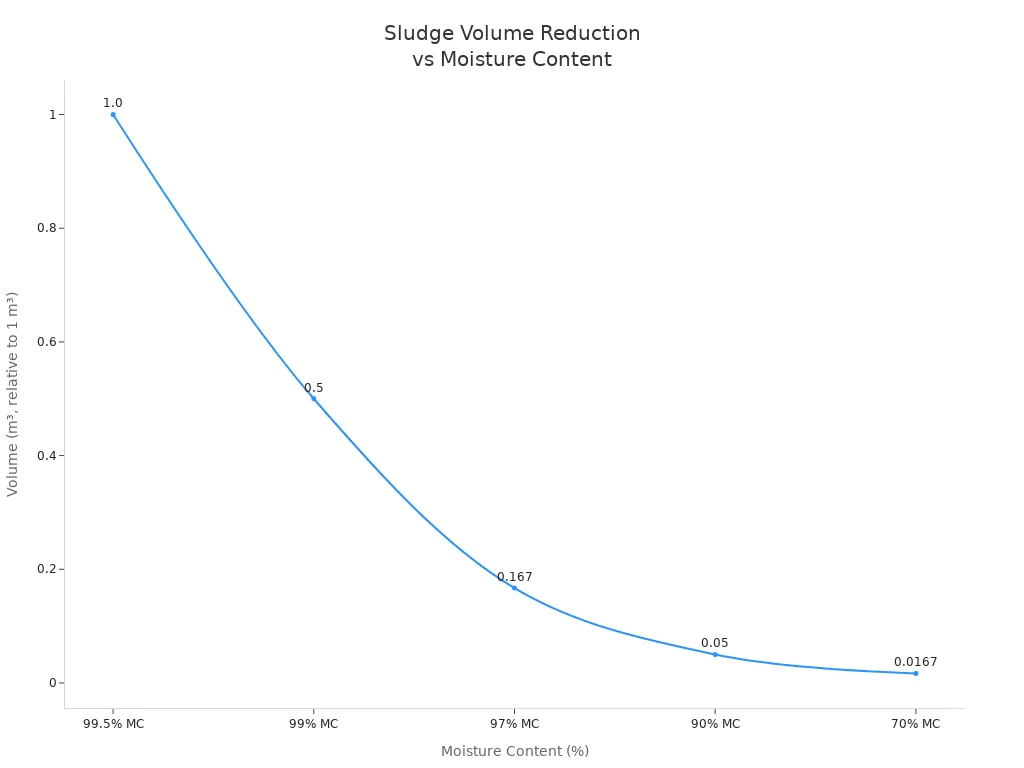
Drying sludge also lowers the cost to get rid of it. Dried sludge is easier to handle and follows rules for some disposal ways. Plants can save money, especially when moving and handling sludge costs a lot.
Odor and Pathogen Control
Drying does more than make sludge smaller. It also helps stop bad smells and kills many germs. High heat during drying takes out water and cuts down on odors. The heat can destroy harmful bacteria, viruses, and parasites. For example, solar dryers with other treatments can remove most germs, like E. coli and Salmonella. Some bacteria may still be there, so extra steps like composting can make sludge even safer.
Note: Sludge drying helps meet rules for germs and odor control, like those in 40 CFR Part 503.
Handling and Disposal Benefits
Dried sludge is much easier to move and store. It does not stick together or smell as much as wet sludge. With more solids, workers can use machines to handle it more easily. The table below lists some main benefits:
Benefit Category | Описание |
|---|---|
Volume and Weight Reduction | Drying makes sludge smaller and lighter, so moving and getting rid of it costs less. |
Pathogen Reduction | Drying kills many germs, so sludge is safer to handle. |
Increased Calorific Value | Dried sludge has more energy, so it can be used as fuel or to make energy. |
Improved Handling | Less water means sludge is easier to move and work with. |
Воздействие на окружающую среду | Some drying methods use less energy and are better for the environment. |
Dried sludge can be used in many ways. It can become fertilizer, soil conditioner, or even fuel for making energy. Some plants use it in building materials. These uses help cities and factories turn waste into something helpful, while saving energy and following environmental rules.
How Sludge Dryers Work
Sludge dryers remove moisture from sludge, converting it into a dry, manageable form. This process involves heating the sludge, which evaporates the water content, leaving behind solid residue.
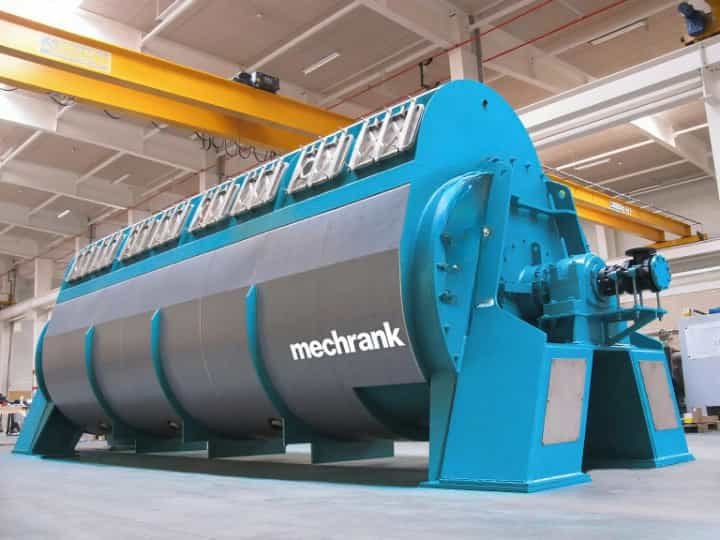
Drying Process Overview
Sludge drying turns wet sludge into a dry product. Wet sludge starts with over 85% water. The goal is to lower this to about 10% or less. This makes it easier to move and store.
The drying process has several steps:
Sludge Feeding: Wet sludge goes into the dryer.
Spreading or Conveying: The sludge spreads out or moves inside the dryer.
Initial Drying (Speed Increasing Stage): The dryer removes free water fast. The drying speed goes up quickly.
Constant Speed Stage: The dryer keeps removing water at the same speed. Most free water leaves the sludge now.
First Speed Reducing Stage: The drying slows down. Water inside the sludge is harder to remove.
Second Speed Reducing Stage: The drying slows even more. Only bound water is left, and the process is almost done.
Output of Dried Sludge: The system lets out the dry sludge. It now has much less water.
Note: Drying sludge makes it smaller and lighter. This helps with moving and storing it.
The chart below shows how water drops as dry solids go up during thermal drying:
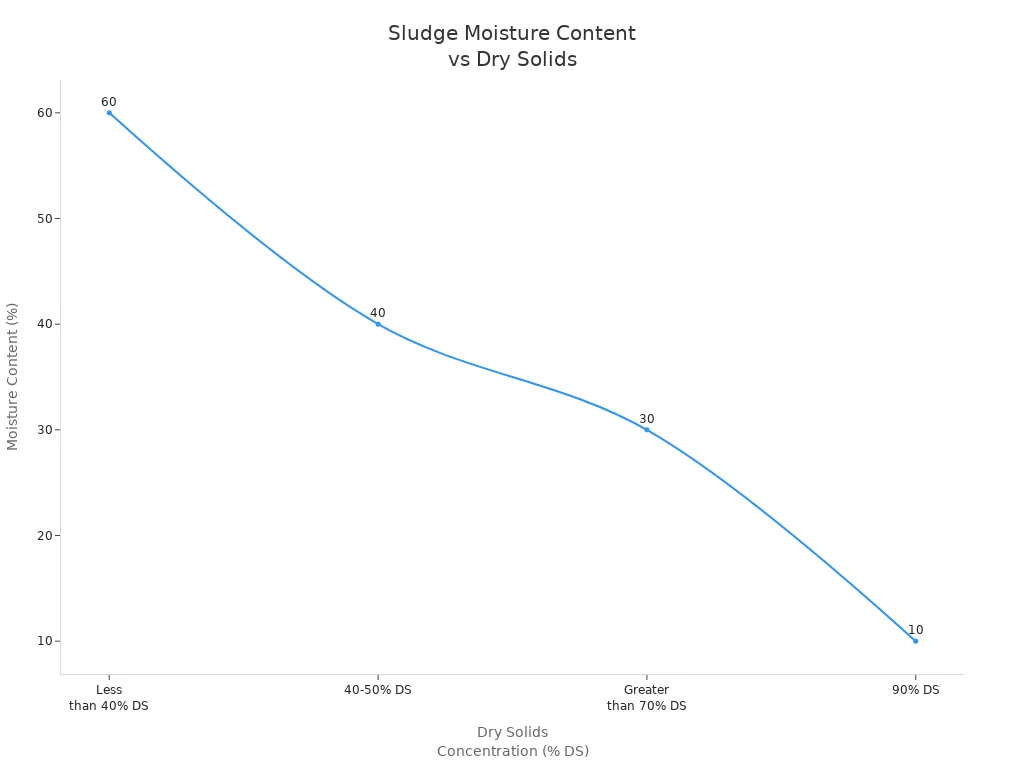
Heat and Mass Transfer
Heat and mass transfer are very important in sludge drying. The dryer uses heat to warm up the sludge. This heat can come from hot air, steam, oil, or sunlight. Heat moves into the sludge by touching it or blowing air. As the sludge gets hot, water turns to vapor and leaves.
Water moves from inside the sludge to the outside. This happens because of temperature and humidity changes. The process follows energy and mass rules. The dryer must match the heat added with the water taken out.
Different dryers use different ways:
Convective Dryers: These use hot air or steam to heat the sludge. Belt dryers and fluidized bed dryers work like this.
Conductive Dryers: These use hot surfaces, like discs or paddles, to heat the sludge. This way loses less heat and makes less odor.
Solar Dryers: These use sunlight to dry the sludge. Sometimes, they add extra heat to go faster.
The heat source changes how much energy is used. Using waste heat or low heat can save energy. Some plants use biogas from sludge to power the dryer. Thermal hydrolysis can help break down sludge, making it easier to dry and making more biogas. This helps save energy.
Tip: Using heat recovery and thermal hydrolysis saves energy and helps drying.
Ключевые компоненты
A modern sludge dryer has many important parts. Each part helps move, heat, dry, and handle the sludge safely.
Компонент | Описание |
|---|---|
Sludge Inlet | Where wet sludge goes into the dryer. |
The main place where heat dries the sludge. | |
Система отопления | Gives heat using hot air, steam, oil, or hot surfaces. |
Agitation/Mixing | Mixes the sludge so it dries evenly and does not clump. |
Discharge Section | Takes out the dried sludge for storage or disposal. |
Uses filters or scrubbers to keep the air clean. | |
Система управления | Checks and changes temperature, water, and airflow for safe use. |
Some advanced systems have:
Direct Heating: Hot gases touch the sludge to heat it.
Indirect Heating: Heat moves through surfaces, so the sludge does not touch the heat source.
Combination Systems: Use both direct and indirect heating to save energy.
Safety and Environmental Controls: Sensors and machines stop overheating and control emissions.
New ideas in sludge drying help save energy and work better. Heat recovery systems reuse heat from the process. Thermal hydrolysis uses heat and pressure to break down sludge before drying. This makes drying easier and makes more biogas. New designs use modular systems and better reactors for different plant sizes.
Callout: Picking the right system and new technology can help sludge dryers work better and use less energy.
How Does Sludge Drying Compare to Other Dewatering?
Sludge drying is often more efficient and cost-effective than other dewatering methods. It reduces sludge volume significantly, minimizes disposal costs, and can produce a stable, odor-free product.
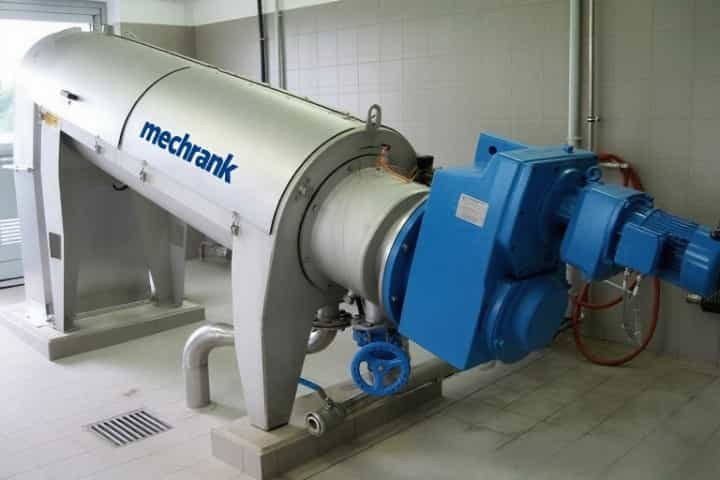
Dewatering vs Drying
Sludge dewatering and sludge drying both take water out of sludge. They do this in different ways. Dewatering uses machines like centrifuges or filter presses. These machines squeeze water out of the sludge. After dewatering, the sludge still has a lot of water. It can have 20% to 80% solids. The sludge is still wet and heavy. This makes it hard and costly to move or get rid of. Drying uses heat to take out even more water. This step can make the sludge much lighter. It can lower the weight by up to 90% and the size by 80%. The end product is dry and easy to handle.
Метод | Final Solids Content | Использование энергии | Disposal Cost | Product Form |
|---|---|---|---|---|
Dewatering | 20%–80% | Низкий | Выше | Wet cake |
Drying | Up to 95% | High (thermal) | Lower (per ton) | Dry granules |
Dewatering costs less because it does not use much energy. But drying makes the sludge lighter and cheaper to move. Many plants use both steps to get the best results.
Composting and Incineration
Composting, incineration, and sludge drying treat sludge in different ways. Composting mixes sludge with other things to make soil. This method is not good for the environment and does not recover many resources. Incineration burns sludge at high heat. It cuts the sludge size by about 90% and makes energy. But it needs dry sludge to work well. Sludge drying gets the sludge ready for burning or other uses. It makes the sludge dry and stable.
Treatment Method | Воздействие на окружающую среду | Resource Recovery | Примечания |
|---|---|---|---|
Composting | High (least favorable) | Низкий | High environmental burden |
Incineration | Low (most favorable) | High (energy production) | Needs dry sludge; reduces volume by ~90% |
Умеренный | Умеренный | Prepares sludge for safe disposal or reuse |
Примечание: More than 70% of sludge in Europe is burned or used as fertilizer. This shows people like methods that recover more resources.
Unique Advantages
Sludge drying has some special benefits over other ways:
It keeps dried sludge and wet sludge apart, so the product stays good.
It makes less waste gas, which helps the environment.
It uses the water that turns to vapor to make the system safer.
These things make sludge drying a good, safe, and green choice. Plants can use it for many kinds of sludge, so it is very flexible.
What Are the Applications of Sewage Sludge After Treatment?
Treated sewage sludge, also known as biosolids, can be applied in several beneficial ways including agriculture, land reclamation, and as a source of energy. These applications help recycle nutrients, improve soil health, and generate renewable energy.
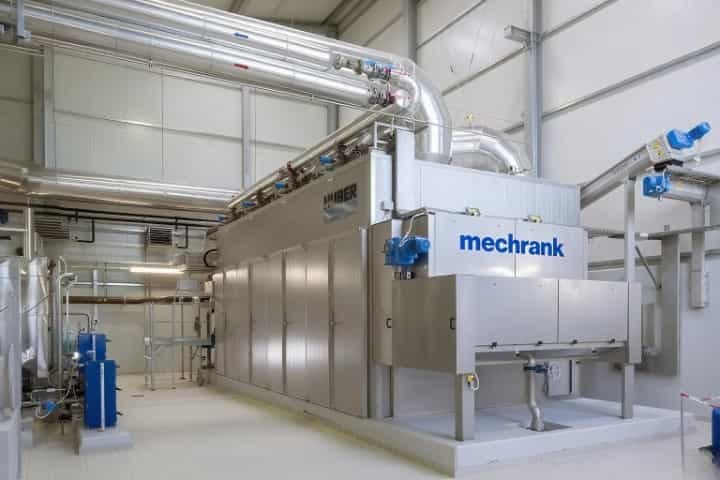
Sewage sludge, a byproduct of wastewater treatment processes, is primarily used in agriculture as a soil amendment and in energy production through anaerobic digestion.
Municipal Wastewater
Municipal wastewater plants use sludge dryers to handle sewage sludge. These dryers take water out of biosolids, digestate, and DAF solids. The main goal is to make the sludge smaller and drier. This makes it easier and cheaper to move. Dried biosolids from cities can be used in many ways:
Farmers use biosolids as fertilizer because they have nutrients.
Parks and sports fields use biosolids to help soil.
Golf courses put biosolids on fairways as a top layer.
Land projects use biosolids to make soil better.
Some places use dried biosolids instead of landfill cover.
Drying biosolids also helps kill germs. The EPA Part 503 Sludge Rule gives rules for killing germs. Class A biosolids are safe to touch, but Class B biosolids have some limits. Drying, composting, and lime treatment are ways to meet these rules. Dried biosolids are easy to store, pack, and move. This saves money and makes useful products.
Tip: Dried biosolids can have metals like gold and silver. This means you can get metals from them.
Industrial Sludge
Industrial sludge comes from factories and other work sites. Sludge dryers treat many types of industrial sludge, like undigested, digested, and strong waste sludges. These dryers can handle sticky and hard-to-dry sludge. They also treat biosolids, digestate, DAF solids, and metal hydroxide waste.
Factories often use heat drying to get sludge ready for more treatment. Machines first take out some water. Then, dryers use heat or sunlight to finish drying. Some factories use special heat methods like pyrolysis and gasification. These heat dried biosolids to get energy back. Pyrolysis makes bio-oil, syngas, and biochar. Gasification makes syngas and ash. Both ways shrink sludge and get energy.
Lime dosing is another way to treat metal hydroxide waste. It raises the pH and makes the sludge stable. This keeps bad metals in the solids and makes more solids. Some plants use fly ash with lime to use less lime.
Application Area | Typical Sludge Types | Main Treatment Methods | End Uses or Benefits |
|---|---|---|---|
Municipal Wastewater | Biosolids, digestate, DAF | Thermal drying, composting | Fertilizer, soil conditioner, cover |
Industrial | Biosolids, metal hydroxide | Thermal drying, pyrolysis | Energy recovery, metal recovery |
Note: Using heat drying and getting energy back helps factories handle biosolids and protect the environment.
Sludge drying is very important in wastewater treatment today. It makes sludge smaller, cuts down on bad smells, and helps make it safer by killing germs. Plants save money because it costs less to move and throw away sludge. They also follow rules better and can reuse dried sludge. The table below shows the main good points:
Role/Benefit | Пояснение |
|---|---|
Volume Reduction | Makes moving and storing sludge cheaper and easier. |
Odor Control | Makes the air better for workers and people nearby. |
Pathogen Reduction | Makes sludge safer to handle. |
Resource Recovery | Lets plants use dried sludge as fertilizer or fuel. |
Environmental Compliance | Helps plants follow the rules. |
Энергоэффективность | New machines use less energy and work better. |
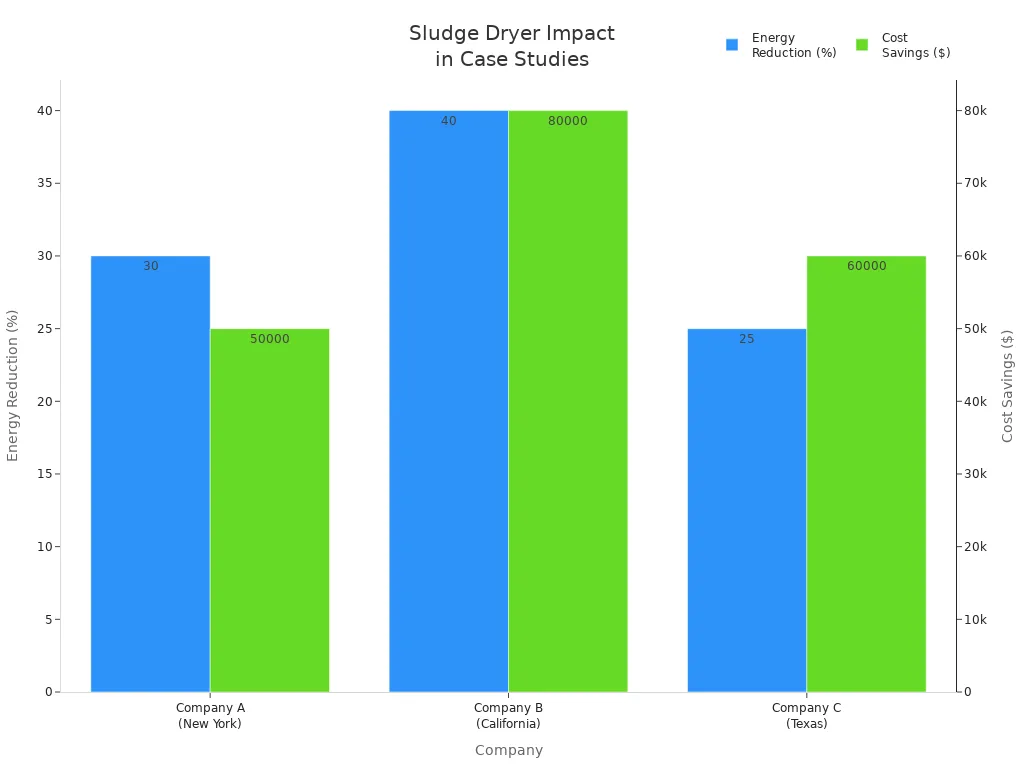
Thermal drying works for many kinds of sludge and jobs. Plants should think about what they need, how much energy they use, and how much money they can save over time before picking a system.
ЧАСТО ЗАДАВАЕМЫЕ ВОПРОСЫ
What is the main purpose of a sludge dryer?
A sludge dryer takes water out of sludge. This makes the sludge lighter and smaller. Plants can move it more easily. It also costs less to get rid of.
Can dried sludge be reused?
Yes, dried sludge can be used again. It is often made into fertilizer or fuel. Some factories use it in building things. Reusing dried sludge saves resources and helps the environment.
Is sludge drying safe for the environment?
Sludge drying helps by cutting down bad smells and killing germs. New dryers have filters and controls to keep the air clean. Plants that save energy also help the environment.
How does sludge drying save money?
Drying sludge makes it weigh less and take up less space. Fewer trucks are needed to move it. Plants also need less room to store it. This means they spend less money overall.

